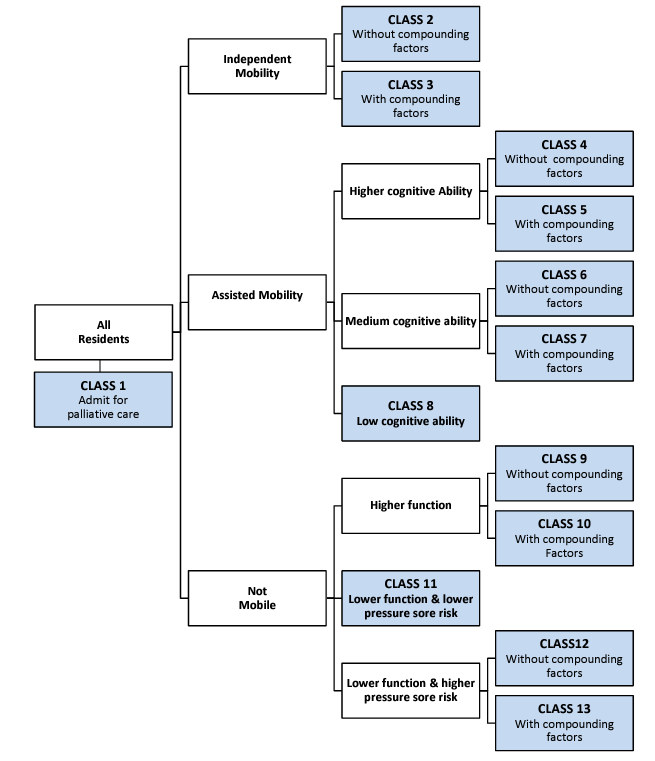04 December 2023
Everything you need to know about the ACFI and AN-ACC
10 min read
The Aged Care Funding Instrument, ACFI
The Aged Care Funding Instrument (ACFI) was a funding tool that captured the care needs of residents in aged care homes. It considered various factors related to the resident's health and assistance required with activities of daily living, behaviour and complex healthcare needs.
Outcomes were then used to allocate Australian Government subsidy to residential aged care providers to care for the residents. However, on 1 October 2022 the ACFI was replaced by a new funding model now known as the Australian National Aged Care Classification (AN-ACC) or shortened to ANACC.
Key points about the formerly used Aged Care Funding Instrument:
Care Domains:
ACFI assessed care needs across three domains:
1. Activities of Daily Living (ADL): Includes tasks such as eating, mobility, personal hygiene, toileting and continence.
-
2. Behaviour: Assesses behavioural and psychological symptoms exhibited by the resident.
-
3. Complex Health Care: Considers the resident's complex health care needs, including treatments for chronic medical conditions.
Funding Allocation:
The results of the formerly used ACFI assessment determined the level of funding that the aged care provider received for each resident. The higher the assessed care needs, the higher the funding allocated for that resident.
Regular Reviews:
ACFI assessments were typically conducted regularly to ensure that the funding allocation reflects the changing care needs of residents over time. Importantly, the assessments were completed by the home’s clinical staff and audited by the Department of Health ACFI review officers.
What assessments are required to enter aged care?
The process of entering aged care in Australia typically involves several assessments. The assessments are designed to evaluate the individuals care needs and to determine the appropriate level of care and support required.
-
1. ACAT/ACAS Assessment:
The first step is often an assessment by the Aged Care Assessment Team (ACAT) or Aged Care Assessment Service (ACAS) in some states. This assessment determines the person's eligibility for government-subsidised aged care services.
-
2. Income and Assets Assessment:
Individuals seeking residential aged care may also undergo an income and assets assessment by Centrelink or DVA to determine the level of their contribution to the cost of care.
-
3. Residential Aged Care Home Assessment:
Once eligibility is established, there may be an assessment by the aged care home to determine whether they can meet the individual's care needs. This individual assessment may include considerations related to the home’s amenities and the individual care services required by the older person.
-
4. Australian National Aged Care Classification (AN-ACC):
The AN-ACC assessment is conducted upon entry into residential care to determine the level of funding the home will receive for providing care to the individual.
What is the Australian National Aged Care Classification? (AN-ACC)
AN-ACC is a funding tool designed to cover the cost of care, mainly, wages of aged care employees who provide care to residents on a day-to-day basis.
Following the Minimum Care Minute Requirement reform which came into effect on 1 October 2023, AN-ACC has a direct impact on the number of employees providing direct care to residents, such as Personal Care Workers and Registered Nurses (RN’s).
Homes with effective processes in place to accurately document residents’ care needs and manage AN-ACC assessments and reassessments will be in the best position to achieve sufficient funding levels, adequate staffing levels and quality care for residents.
Every resident is assessed by an external AN-ACC assessor and assigned an AN-ACC class. There are 13 classes for permanent residents and 3 for respite. Each AN-ACC class is allocated a funding rate and a minimum care minute target to be provided by all care staff and a separate target for RN minutes.
AN-ACC assessments are conducted by independent assessors, who are qualified Registered Nurses, Physiotherapists or Occupational Therapists, with at least five years of clinical experience. The assessors are required to complete a suite of assessments to assign the resident an AN-ACC Class. They will review care documentation, observe and interact with the resident and interview staff about assistance provided.
What aspects or resident care are considered in AC-ACC?
AN-ACC is designed to capture resident’s care needs that require staff assistance, including the following:
Care:
|
Mobility |
Assistance with bed mobility, transfers, walking or pushing a wheelchair. Mobility has the highest impact on the resident’s AN-ACC class. |
|
ADL |
Assistance with eating, personal hygiene, dressing, grooming, toileting and continence. |
|
Cognition |
Short and long-term memory, communication, sequencing tasks, social skills and problem-solving. |
|
Behaviour |
Verbal and physical behaviours, wandering, emotional dependence and danger to self or others. |
|
Technical Nursing |
Wound management, daily injections, oxygen therapy, enteral feeding, stoma care, catheter care, tracheostomy, and peritoneal dialysis. |
AN-ACC Classifications
 Source: Resource Utilisation and Classification Study (RUCS) Reports
Source: Resource Utilisation and Classification Study (RUCS) Reports
There are several potential benefits to the AN-ACC. These include:
-
1. Simplified Administration:
The reform aimed to simplify administrative processes by streamlining the assessment and funding allocation system.
-
2. Responsive to Changing Care Needs:
AN-ACC is expected to be more responsive to changes in residents' care needs over time. This adaptability could ensure that funding allocations better align with the evolving requirements of individuals in aged care.
-
3. Promoting reablement in residential care:
One of the benefits of AN-ACC is that it promotes reablement in residential care. Unlike the ACFI, the funding is not reduced when the residents condition improves. Also, AN-ACC is not linked to specific treatments, which allows clinical teams and allied health professionals to tailor treatment plans for each resident according to their individual care needs.
If you would like further information on AN-ACC please visit The Australian National Aged Care Classification (AN-ACC) funding guide
For further articles from Estia Health, see:
